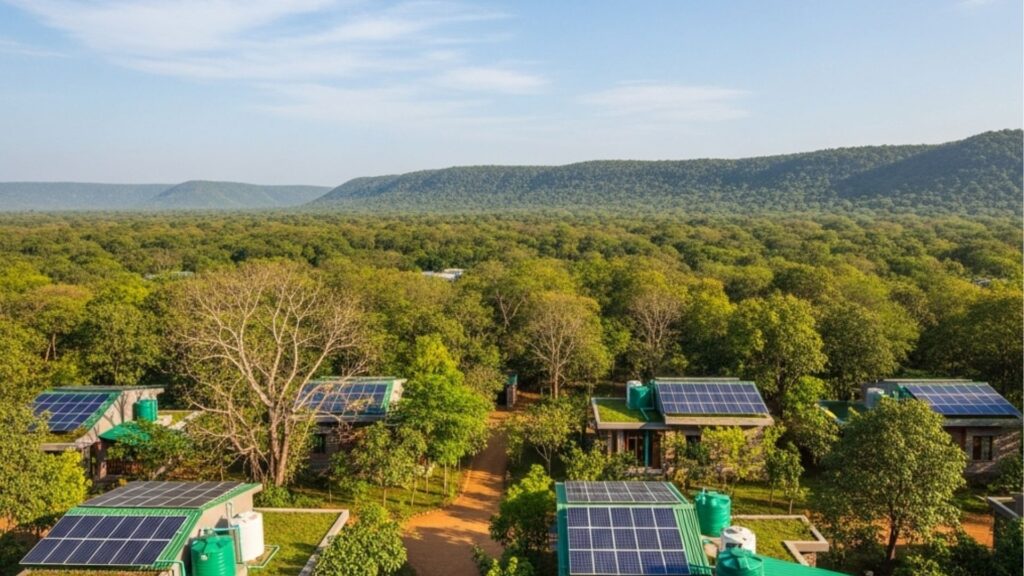Urban growth often extends into areas close to forests, wildlife habitats, and ecologically important regions. To protect these natural assets, the Government of India has designated Eco-Sensitive Zones (ESZs) around protected areas. These buffer zones are meant to balance environmental protection with sustainable development. For property developers, investors, and homebuyers, understanding ESZ regulations is essential before planning or purchasing projects in such regions.

Table of Contents
What Are Eco-Sensitive Zones?
Eco-Sensitive Zones are areas notified by the Ministry of Environment, Forest and Climate Change (MoEF&CC) around national parks, wildlife sanctuaries, and other protected areas. They generally extend up to 10 kilometers from the boundaries of these protected zones, although the exact extent varies depending on ecological needs and site-specific assessments.
The primary aim of ESZs is to reduce the negative impact of human activities on fragile ecosystems while allowing certain regulated development that meets environmental safeguards.
Activities Regulated in Eco-Sensitive Zones (ESZs)
The ESZ notification classifies activities into three categories:
- Prohibited: Activities like mining, large-scale industrial operations, and certain construction types are not allowed.
- Regulated: Projects such as small-scale construction, tourism facilities, and infrastructure may be permitted with strict environmental clearances.
- Permitted: Agriculture, horticulture, and eco-tourism activities that support local livelihoods are generally allowed.
This framework ensures that growth does not compromise ecological balance.
Impact on Property Development
For property developers, ESZ regulations influence both what can be built and how it can be built.
1. Limitations on Land Use
Development within Eco-Sensitive Zones (ESZs) is subject to tighter scrutiny. Large-scale housing or commercial projects may face restrictions on building height, density, and plot coverage.
2. Higher Approval Requirements
Projects in these zones often require additional permissions from environmental authorities, which can extend timelines and increase compliance costs.
3. Design and Construction Modifications
Developers may need to incorporate eco-friendly designs, use sustainable materials, and ensure minimal disturbance to local biodiversity.
4. Increased Due Diligence for Buyers
Homebuyers looking to invest in properties near Eco-Sensitive Zones should verify whether the project has obtained the necessary clearances to avoid future legal complications.
Opportunities in ESZ-Compliant Development
While ESZ regulations may seem restrictive, they also open doors for responsible and innovative property development.
- Eco-Tourism Projects: Resorts, homestays, and nature-centric hospitality developments that promote conservation can thrive in such locations.
- Green Residential Communities: Low-impact housing projects with renewable energy systems, water recycling, and green landscaping can appeal to environmentally conscious buyers.
- Long-Term Value: Properties in ecologically preserved areas often benefit from cleaner surroundings and natural beauty, which can enhance their appeal and resale value.
Balancing Conservation and Development
The challenge lies in balancing economic growth with ecological protection. Governments, developers, and local communities must collaborate to create development plans that safeguard natural habitats while meeting human needs.
For instance, zoning maps can clearly demarcate areas where development is permitted, restricted, or prohibited. Incentives like faster approvals or tax benefits for eco-friendly designs can encourage compliance.
Legal Considerations for Developers and Investors
Before starting any project near an ESZ, stakeholders must:
- Review the official ESZ notification for the concerned area.
- Seek environmental impact assessments (EIA) where required.
- Obtain clearances from the State Environment Impact Assessment Authority (SEIAA) or central authorities.
- Engage with local communities to ensure alignment with conservation goals.
Ignoring these steps can lead to project delays, legal disputes, or even demolition orders.
The Role of Awareness in Responsible Development
Lack of awareness about ESZ rules often leads to unintentional violations. Developers and buyers must be informed about:
- The specific activities allowed in the zone.
- The environmental implications of their projects.
- The long-term benefits of preserving ecological integrity.
Conclusion
Eco-Sensitive Zones are a critical part of India’s environmental policy, acting as protective buffers for the country’s rich biodiversity. For property development, they present both challenges and opportunities. Projects near ESZs require careful planning, strict compliance with regulations, and a commitment to sustainability.
By understanding the rules and adopting eco-friendly practices, developers and investors can contribute to conservation while also creating properties with long-term value. In the evolving landscape of Indian real estate, ESZ-compliant projects are not just a legal necessity—they are a step toward a more sustainable future.
Frequently Asked Questions
Q. Can I buy land in an Eco-Sensitive Zone?
Yes, you can purchase land in an ESZ, but usage and development are subject to strict regulations. Any construction or modification must comply with the zone’s specific guidelines and obtain required clearances.
Q. Do ESZ rules apply to existing buildings?
Existing structures may remain, but any major renovation, expansion, or change in land use will likely require environmental permissions in line with ESZ norms.
Q. Are ESZ boundaries the same for all protected areas?
No, the extent of an ESZ varies depending on the ecological sensitivity of the area. It can range from a few hundred meters to up to 10 kilometers from the protected area’s boundary.